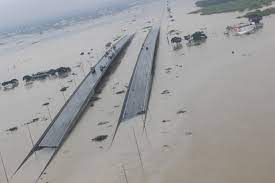Chennai Rains : A Brief Overview from 2015 to Till Now

Introduction
The 2015 South India floods were caused by significant rainfall from the annual northeast monsoon in November and December 2015. They impacted the Coromandel Coast region of Tamil Nadu and Andhra Pradesh in South India. Over 500 people were killed, and more than 1.8 million (18 lakh) were displaced. The floods were the most expensive natural disasters to occur in 2015, with estimates of damages and losses ranging from nearly 200 billion (US$3 billion) to over 1 trillion (US$13 billion).
Though the unusually heavy rainfall in southern India during the winter of 2015 has been attributed to the 2014-16 El Nio event, the Comptroller and Auditor General of India (CAG) classified the flooding across Tamil Nadu as a “man-made disaster” in July 2018, and held the Tamil Nadu government responsible for the scale of the disaster, which the latter had termed a natural disaster.
Explanation based on geography and meteorology
From October to December each year, a major portion of south India, including Tamil Nadu, coastal Andhra Pradesh, and the union territory of Puducherry, receives up to 60% of its annual rainfall from the northeast monsoon (or winter monsoon). The northeast monsoon is caused by the annual ebb and flow of monsoonal rains from northeastern India. Rainfall during the northeast monsoon is sporadic, as opposed to the regular monsoon, but it typically far exceeds the amount produced by the regular monsoon by up to 90 percent. This excessive rainfall can be exacerbated by an El Nio of the magnitude that has since been assigned to every year, including 2015.
The coastal areas of Andhra Pradesh normally suffer the brunt of heavy rains that occur during the northeast monsoon; Puducherry and eastern Tamil Nadu are prone to floods due to their numerous river systems and wetlands. Between 1943 and 2005, Chennai alone had five significant floods, with the 1943, 1978, and 2005 floods causing particularly catastrophic damage. Furthermore, uncontrolled and often illegal urban development has resulted in the destruction of numerous wetlands and natural sinks; this, combined with aging civic infrastructure and poorly engineered drainage systems, has resulted in a rise in the frequency of catastrophic flooding.
Weather System
During the annual cyclone season, on November 8, 2015, a low-pressure region consolidated into a depression and gradually deepened into a deep depression before hitting the coast of Tamil Nadu near Puducherry the following day. On November 10, the system weakened into a well-defined low-pressure area over north Tamil Nadu due to terrain interaction and significant vertical wind shear. The system dumped a lot of rain on the coastal and north interior districts of Tamil Nadu. Kanchipuram had 340 mm of rain on November 13th, inundating some low-lying areas, while Vembakkam, adjacent to Kanchipuram, received 470 mm. On the 15th of November, a well-defined low-pressure region moved north along the Tamil Nadu coast, dumping massive amounts of rain over coastal Tamil Nadu and Andhra Pradesh, with 24-hour totals peaking at 370 mm in Ponneri. In 24 hours, Chennai International Airport received 266 mm of rain. Another system formed on the 28th and 29th of November and arrived over Tamil Nadu on the 30th, bringing more rain and flooding.
Tambaram received 490 mm of rain in 24 hours beginning at 8:30 a.m. on December 1. Flooding occurred over the entire stretch of coast from Chennai to Cuddalore as a result of severe rains. According to an IISc study, clouds were stationary above Chennai on December 1st. According to this study, the Eastern Ghats mountains prevented clouds from traveling further inland from the Bay of Bengal. The mechanism is known as ‘upstream blocking.’ As a result, they remained stationary over Chennai all day. These clouds produced continuous rainfall over Chennai, resulting in massive flooding.
Chennai
Neyveli experienced 483 mm (19.0 in) of rainfall during November 9 and 10, 2015; showers continued to lash Cuddalore, Chidambaram, Tiruvallur, Kanchipuram, and Chennai. Several low-lying sections in Kanchipuram, including major thoroughfare Gandhi Road, were submerged as the city and its surroundings got 340mm of rain in the 24-hour period ending at 8.30 a.m. on November 13, 2015.
The Manjalneer Kalvai, primarily a flood drain channel for the city, overflowed in the early hours of Friday after the Netteri lake breached on the Kancheepuram-Vellore Road, flooding the entire stretch of Gandhi Road and Munusamy Mudaliyar Avenue and forcing police to close the prime junction Moongil Mandapam where the Gandhi Road meets Vallal Pachaiyappan Salai. Kanchipuram Collector R.Gajalakshmi later told reporters that a total of 7,294 people were evacuated from waterlogged regions and housed in the city body’s 26 shelters.
Boats were utilized to rescue residents from submerged regions in Pillayarpalayam, according to the Collector. In addition, Vembakkam, in Kanchipuram, received 470mm of rain on November 13, 2015. Continued rains caused low-lying areas of Chennai to become inundated by November 13, forcing over 1000 people to flee their homes. Flooding in Chennai was exacerbated by years of illegal development and inadequate flood preparedness. On the 17th of November, much of the city was still flooded, despite the fact that the rain had mostly stopped. In November, Chennai received 1,049 mm (41.3 in) of rain, the most since November 1918, when 1,088 mm (42.8 in) of rain fell.
Kancheepuram district received the most rain, 183% more than the average of 64 cm in October-December, and Tiruvallur district received 146 cm more than the average of 59 cm. Chennai’s flooding was hailed as the worst in a century.Due to the continuing rains, schools and colleges in Puducherry, Chennai, Kancheepuram, and Tiruvallur districts in Tamil Nadu remained closed, while fishermen were advised not to sail due to high waters and hazardous seas.
The state government issued a detailed final statement in January 2016, stating that 421 people died of flood-related causes in Tamil Nadu between 28 October, when the first monsoonal rains began, and 31 December; however, relief workers alone reported hundreds more who were missing, and various police reports put the death toll in the Chennai region alone at over 500 as of mid-December. As floodwaters began to recede in the second week of December, Chennai-area morgues and crematoria were said to be “piled up” with bodies, while all of the still-operational local cemeteries had recorded more than three times the average number of burials, up from a normal 25-30 burials per week.
The Tamil Nadu government reported that 3042,000 (3.042 million) people sustained whole or partial damage to their homes. Flooding had destroyed 3,8276.8 million hectares of crops, including around 347,000 hectares of agricultural crops and 35,471 hectares of horticultural crops; over 98,000 livestock animals and fowl had died. The skeleton of a man reported missing during the floods was discovered on April 25, 2018, in the Chennai neighborhood of Peerkankaranai near Tambaram, albeit a definitive identification could not be made right away.
Present Situation
Rainfall and thunderstorms are expected to continue this week, according to the latest weather forecast from the India Meteorological Department. New Delhi, India – At least two people were killed in rain-related events in Chennai on Tuesday, November 2, when the city experienced its worst downpour in decades.
According to the India Meteorological Department (IMD), a low-pressure area currently over the southeast Bay of Bengal is expected to move west-northwestwards and gradually concentrate into a depression over the central parts of the south BoB by Sunday.
Following that, the system is expected to move west-northwestwards — towards the coasts of Tamil Nadu-Puducherry and south Andhra Pradesh — over the next three days, causing average to above-average precipitation (for this time of year) across South India next week.
The rains are being caused by a new low pressure region that has formed over the southeast Bay of Bengal and the adjacent north Andaman Sea. Around November 19, it is expected to move west-northwestwards and eventually consolidate into a depression over the central sections of the south Bay of Bengal.
The sky in Chennai will be partly cloudy for the next two days. In the early morning hours, mist or haze is likely. At their highest and lowest points, temperatures will range between 30 and 22 degrees Celsius.
Conclusion
The north-east and retreating monsoons provide the majority of Chennai’s rainfall during the winter months. Additionally, during this time, a lot of low pressure systems develop in the Bay of Bengal and move eastward along the coast of Tamil Nadu, bringing heavy rain. There are 157.6 days with rain each year, and the average amount of precipitation is 823 mm (32.4″). 8.4 cm of rain fall in one day in Chennai, the most in 30 years.



